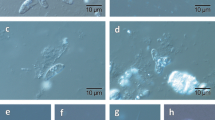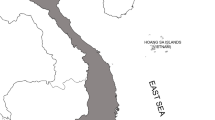Abstract
Purpose
The class Myxozoa consists of microscopic spores that typically present uniform morphological simplifications, containing one or two sporoplasms surrounded by valve cells. The present study analysed the morphological and phylogenetic characteristics of what proved to be a new species of Ceratomyxa found in the gallbladder of Mesonauta festivus Heckel, 1840 captured on the Piririm River in the municipality of Macapá, in Amapá state, Brazil.
Methods
The fish were collected in gillnets, and were transported alive to Amapá State University in Macapá for the analysis of the organs. Crescent- or arch-shaped free spores were observed under light microscopy, containing two polar capsules and a suture line, which is typical of the morphology of the genus Ceratomyxa, contained within plasmodia that had snake-like movements. The gallbladder was conserved in 80% alcohol for the analysis of the 18S rDNA gene, and in Davidson solution for standardhistology.
Results
Ceratomyxa spores (n = 20) were observed in 11 of the 50 samplesanalysed, and thus had a prevalence of 22%, and had a mean length of 4.2 ± 0.5 µm, mean thickness of 22.75 ± 0.3 µm, and two polar capsules, 1.86 ± 0.3 µm long and 1.63 ± 0.1 µm thick.
Conclusions
The phylogenetic analysis indicated that the new species forms a cluster with other freshwater Amazonian Ceratomyxa species, described previously. The new species represents the first description of a taxon of the genus Ceratomyxain fish from the Brazilian state of Amapá.




Similar content being viewed by others
Availability of data and materials
Not applicable.
Code availability
Not applicable.
References
Eiras JC, Takemoto RM, Pavanelli GC (2010) Métodos de estudo e técnicas laboratoriais em parasitologia de peixes. Ed. EDUEM, 2ed
Gonçalves RA, Oliveira MSB, Santos EF, Tavares-Dias M (2014) Aspectos ecológicos da comunidade de parasitos em duas espécies de Loricariidae da Bacia Igarapé Fortaleza, Estado do Amapá. Brasil Biota Amazônia 4(1):15–21
Pires THS, Campos DF, Röpke CP et al (2015) Ecology and life-history of Mesonauta festivus: biological traits of a broad ranged and abundant Neotropical cichlid. Environ Biol Fish 98:789–799. https://doi.org/10.1007/s10641-014-0314-z
Azevedo C, Ribeiro M, Clemente SCS, Casal G, Lopes L, Matos P, Al-Quraishy AS, Matos E (2011) Light and ultrastructural description of Meglitschia mylei n. sp.(Myxozoa) from Myleus rubripinnis (Teleostei: Serrasalmidae) in the Amazon River system. J Eukaryot Microbiol 58(6):525–528. https://doi.org/10.1111/j.1550-7408.2011.00583.x
Silva MF, Carvalho AEFB, Hamoy I, Matos E (2020) Coelozoic parasite of the family Ceratomyxidae (Myxozoa, Bivalvulida) described from motile vermiform plasmodia found in Hemiodusunimaculatus Bloch, 1794. Parasitol Res 119(3):871–878. https://doi.org/10.1007/s00436-019-06505-5
Takeuchi F, Sekizuka T, Ogasawara Y, Yokoyama H, Kamikawa R et al (2015) The mitochondrial genomes of a Myxozoan Genus Kudoa are extremely divergent in metazoa. PLoS ONE 10(7):e0132030. https://doi.org/10.1371/journal.pone.013203
Eiras JC, Cruz C, Saraiva A (2018) Synopsis of the species of CeratomyxaThélohan, 1892 (Cnidaria, Myxosporea, Ceratomyxidae) described between 2007 and 2017. Syst parasitol 95(5):427–446. https://doi.org/10.1007/s11230-018-9791-3
Gunter NL, Whipps CM, Adlard RD (2009) Ceratomyxa (Myxozoa: Bivalvulida): robust taxon or genus of convenience? Int J Parasitol 39(12):1395–1405. https://doi.org/10.1016/j.ijpara.2009.04.008
Lom J, Arthur JR (1989) A guideline for the preparation of species descriptions in Myxosporea. J Fish Dis 12:151–156. https://doi.org/10.1111/j.1365-2761.1989.tb00287.x
Luna LG (1968) In: Luna LG (ed). Manual of Histologic Staining Methods of the Armed Forces Institute of Pathology, California. pp 38–39
Bush AO, Lafferty KD, Lotz JM, Shostak W (1997) Parasitology meets ecology on its own terms: Margolis et al. Revisited. J Parasitol 83:575–583
Barta JR, Martin DS, Liberator PA, Dashkevicz M, Anderson JW, Feighner SD, Elbrecht A, Perkins-Barrow A, Jenkins MC, Danforth HD, Ruff MD, Profous-Juchelka H (1997) Phylogenetic relationships among eight Eimeria species infecting domestic fowl inferred using complete small subunit ribosomal DNA sequences. J Parasitol 83:262–271. https://doi.org/10.2307/3284453
Whipps CM, Adlard RD, Bryant MS, Lester RGJ, Findlav V, Kent M (2003) First report of three Kudoa species from eastern Australia: Kudoathyrsites from mahi mahi (Coryphaenahippurus), Kudoaamamiensis and Kudoaminithyrsites n. sp. from sweeper (Pempherisypsilychnus). J Eukaryot Microbiol 50(3):215–219. https://doi.org/10.1111/j.1550-7408.2003.tb00120.x
Diamant A, Whipps CM, Kent ML (2004) A new species of Sphaeromyxa (Myxosporea: Sphaeromyxina: Sphaeromyxidae) in devil firefish, Pterois miles (Scorpaenidae), from the northern Red Sea: morphology, ultrastructure, and phylogeny. JParasitol 90(6):1434–1442. https://doi.org/10.1645/GE-336R
Adriano EA, Okamura B (2017) Motility, morphology and phylogeny of the plasmodial worm, Ceratomyxa vermiformis n. sp. (Cnidaria: Myxozoa: Myxosporea). Parasitol 144(2):158–168. https://doi.org/10.1017/S0031182016001852
Hall TA (2019) Bioedit v7.0.9: Biological sequence alignment editor analysis program for Windows 95/98/Nt/2K/XP
Holzer AS, Wooten R, Sommerville C (2007) The secondary structure of the unusually long 18S ribosomal RNA of the myxozoanSphaerospora truttae and structural evolutionary trends in the Myxozoa. Int J Parasitol 37:1281–1295. https://doi.org/10.1016/j.ijpara.2007.03.014
Posada D (2008) jModelTest: phylogenetic model averaging. Mol Biol Evol 25:1253–1256. https://doi.org/10.1093/molbev/msn083
Swofford DL, Sullivan J (2003) Phylogeny inference based on parsimony and other methods using PAUP. The Phylogenetic Handbook: a practical approach to DNA and protein phylogeny, vol. 7. 160–206
Drummond AJ, Suchard MA, Xie D, Rambaut A (2012) Bayesian phylogenetics with BEAUti and the BEAST 1.7.Mol. Biol Evol 29:1969–1973. https://doi.org/10.1093/molbev/mss075
Brooks S, Gelman A, Jones GL, Meng X (2011) Handbook of Markov Chain Monte Carlo. CRC Press, New York. https://doi.org/10.1201/b10905
Zatti SA, Atkinson SD, Maia AA, Bartholomew JL, Adriano EA (2017) Ceratomyxagracillima n. sp. (Cnidaria: Myxosporea) provides evidence of panmixia and ceratomyxid radiation in the Amazon basin. Parasitology 145(9):1137–1146. https://doi.org/10.1017/S0031182017002323
Zatti SA, Atkinson SD, Bartholomew JL, Maia AAM, Adriano EA (2017) Amazonian waters harbour an ancient freshwater Ceratomyxa lineage (Cnidaria: Myxosporea). Acta Trop 169:100–106. https://doi.org/10.1016/j.actatropica.2017.02.006
Mathews PD, Naldoni J, Maia AA, Adriano EA (2016) Morphology and small subunit rDNA-based phylogeny of Ceratomyxaamazonensis n. sp. parasite of Symphysodon discus, an ornamental freshwater fish from Amazon. Parasitol Res 115:4021–4025. https://doi.org/10.1007/s00436-016-5173-4
Burger MAA, Adlard RD (2010) Four new species of KudoaMeglitsch, 1947 (Myxosporea: Multivalvulida) from Australia with recommendations for species descriptions in the Kudoidae. Parasitology 137:793–814. https://doi.org/10.1017/S0031182009991557
Fiala I, Bartošová-Sojková P, Whipps CM (2015) Classification and phylogenetics of Myxozoa. In: Okamura B, Gruhl A, Bartholomew JL (eds) Myxozoan Evolution, Ecology and Development. Springer International Publishing, Switzerland, pp 85–110
Azevedo C, Rocha S, Casal G, Clemente SCS, Matos P, Al-Quraishy S, Matos E (2013) Ultrastructural description of Ceratomyxamicrolepis sp. nov. (Phylum Myxozoa): a parasite infecting the gall bladder of Hemiodusmicrolepis, a freshwater teleost from the Amazon River. Mem Inst Oswaldo Cruz 108(2):150–154. https://doi.org/10.1590/0074-0276108022013004
Adriano EA, Okamura B (2017) Motility, morphology and phylogeny of the plasmodial worm, Ceratomyxa vermiformis n. sp. (Cnidaria: Myxozoa: Myxosporea). Parasitology 144(2):158–168. https://doi.org/10.1017/S0031182016001852
Acknowledgements
We are grateful to the Health of Aquatic Organisms of the Amazon research group (SOAA) of Amapá State University (UEAP), the Carlos Azevedo Research Laboratory (LPCA) of the Federal Rural University of the Amazon (UFRA), the Applied Genetics Laboratory of the UFRA, The Federal University of Amapá, and the Brazilian Coordination for Higher Education Personnel Training (CAPES).
Funding
Not applicable.
Author information
Authors and Affiliations
Contributions
Luana da Silva Bittencourt: investigation, methodology, formal analysis, writing—original draft and writing—review and editing. Diehgo Tuloza da Silva: methodology and formal analysis; Igor Hamoy: methodology and formal analysis; Abthyllane Amaral de Carvalho: methodology and writing—review and editing. Luana da Silva Bittencourt: methodology. Igor Hamoy: methodology. Marcela Videira: conceptualization, methodology, project administration, supervision and writing—review and editing. José Carlos Tavares Carvalho: supervision and writing—review and editing. Edilson Matos: conceptualization, resources, supervision and writing—review and editing.
Corresponding author
Ethics declarations
Conflict of interest
Not applicable.
Ethical approval
Animal Use Committee of the Brazilian Agricultural Research Corporation (EMBRAPA)—Amapá (012-2018) and the Biodiversity Authorization and Information System, IBAMA (SISBIO/ICMBIO license number 50376-1).
Consent to participate
Not applicable.
Consent for publication
Not applicable.
Additional information
Publisher's Note
Springer Nature remains neutral with regard to jurisdictional claims in published maps and institutional affiliations.
Rights and permissions
About this article
Cite this article
Bittencourt, L.S., da Silva, D.T., Hamoy, I. et al. Morphological and Phylogenetic Features of Ceratomyxa macapaensis n. sp. (Myxozoa: Ceratomyxidae) in Mesonauta festivus Heckel, 1840 (Cichliformes: Cichlidae) from the Eastern Amazon Region. Acta Parasit. 67, 322–329 (2022). https://doi.org/10.1007/s11686-021-00460-x
Received:
Accepted:
Published:
Issue Date:
DOI: https://doi.org/10.1007/s11686-021-00460-x




